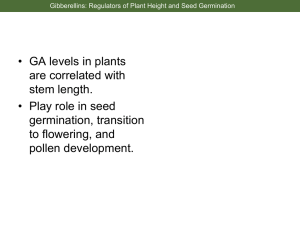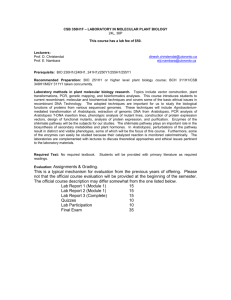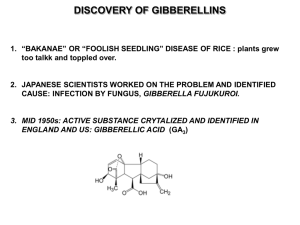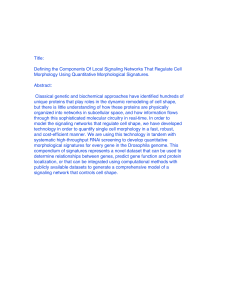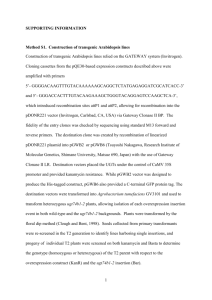Update on Gibberellin Signaling. A Tale of the Tall and 1
advertisement
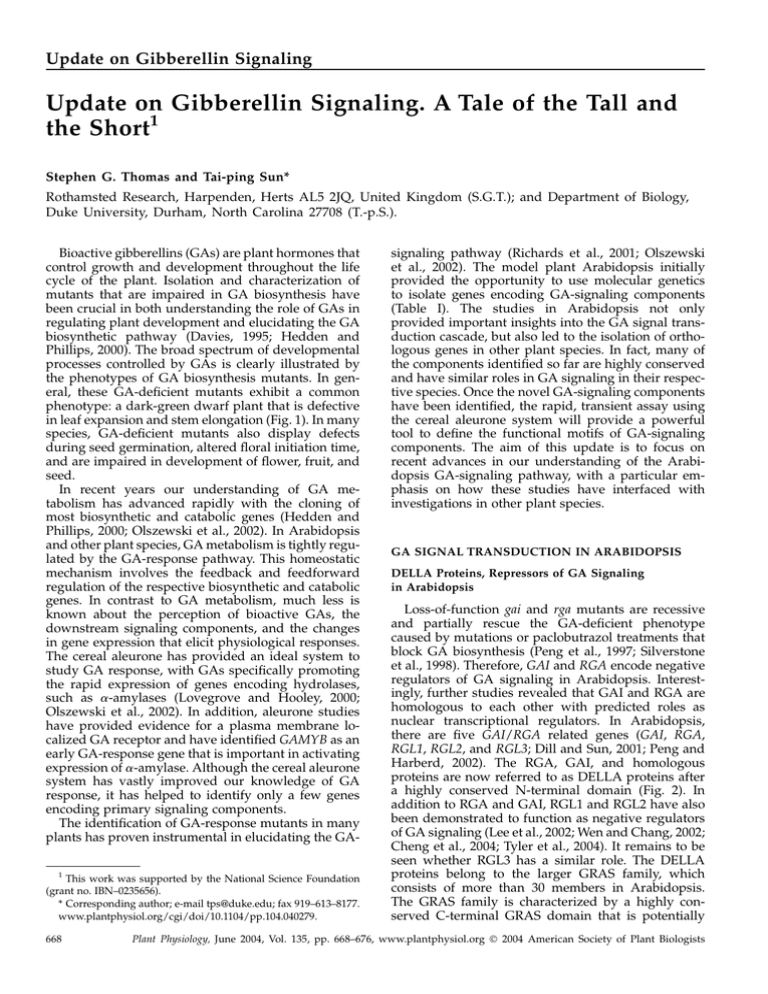
Update on Gibberellin Signaling Update on Gibberellin Signaling. A Tale of the Tall and the Short1 Stephen G. Thomas and Tai-ping Sun* Rothamsted Research, Harpenden, Herts AL5 2JQ, United Kingdom (S.G.T.); and Department of Biology, Duke University, Durham, North Carolina 27708 (T.-p.S.). Bioactive gibberellins (GAs) are plant hormones that control growth and development throughout the life cycle of the plant. Isolation and characterization of mutants that are impaired in GA biosynthesis have been crucial in both understanding the role of GAs in regulating plant development and elucidating the GA biosynthetic pathway (Davies, 1995; Hedden and Phillips, 2000). The broad spectrum of developmental processes controlled by GAs is clearly illustrated by the phenotypes of GA biosynthesis mutants. In general, these GA-deficient mutants exhibit a common phenotype: a dark-green dwarf plant that is defective in leaf expansion and stem elongation (Fig. 1). In many species, GA-deficient mutants also display defects during seed germination, altered floral initiation time, and are impaired in development of flower, fruit, and seed. In recent years our understanding of GA metabolism has advanced rapidly with the cloning of most biosynthetic and catabolic genes (Hedden and Phillips, 2000; Olszewski et al., 2002). In Arabidopsis and other plant species, GA metabolism is tightly regulated by the GA-response pathway. This homeostatic mechanism involves the feedback and feedforward regulation of the respective biosynthetic and catabolic genes. In contrast to GA metabolism, much less is known about the perception of bioactive GAs, the downstream signaling components, and the changes in gene expression that elicit physiological responses. The cereal aleurone has provided an ideal system to study GA response, with GAs specifically promoting the rapid expression of genes encoding hydrolases, such as a-amylases (Lovegrove and Hooley, 2000; Olszewski et al., 2002). In addition, aleurone studies have provided evidence for a plasma membrane localized GA receptor and have identified GAMYB as an early GA-response gene that is important in activating expression of a-amylase. Although the cereal aleurone system has vastly improved our knowledge of GA response, it has helped to identify only a few genes encoding primary signaling components. The identification of GA-response mutants in many plants has proven instrumental in elucidating the GA1 This work was supported by the National Science Foundation (grant no. IBN–0235656). * Corresponding author; e-mail tps@duke.edu; fax 919–613–8177. www.plantphysiol.org/cgi/doi/10.1104/pp.104.040279. 668 signaling pathway (Richards et al., 2001; Olszewski et al., 2002). The model plant Arabidopsis initially provided the opportunity to use molecular genetics to isolate genes encoding GA-signaling components (Table I). The studies in Arabidopsis not only provided important insights into the GA signal transduction cascade, but also led to the isolation of orthologous genes in other plant species. In fact, many of the components identified so far are highly conserved and have similar roles in GA signaling in their respective species. Once the novel GA-signaling components have been identified, the rapid, transient assay using the cereal aleurone system will provide a powerful tool to define the functional motifs of GA-signaling components. The aim of this update is to focus on recent advances in our understanding of the Arabidopsis GA-signaling pathway, with a particular emphasis on how these studies have interfaced with investigations in other plant species. GA SIGNAL TRANSDUCTION IN ARABIDOPSIS DELLA Proteins, Repressors of GA Signaling in Arabidopsis Loss-of-function gai and rga mutants are recessive and partially rescue the GA-deficient phenotype caused by mutations or paclobutrazol treatments that block GA biosynthesis (Peng et al., 1997; Silverstone et al., 1998). Therefore, GAI and RGA encode negative regulators of GA signaling in Arabidopsis. Interestingly, further studies revealed that GAI and RGA are homologous to each other with predicted roles as nuclear transcriptional regulators. In Arabidopsis, there are five GAI/RGA related genes (GAI, RGA, RGL1, RGL2, and RGL3; Dill and Sun, 2001; Peng and Harberd, 2002). The RGA, GAI, and homologous proteins are now referred to as DELLA proteins after a highly conserved N-terminal domain (Fig. 2). In addition to RGA and GAI, RGL1 and RGL2 have also been demonstrated to function as negative regulators of GA signaling (Lee et al., 2002; Wen and Chang, 2002; Cheng et al., 2004; Tyler et al., 2004). It remains to be seen whether RGL3 has a similar role. The DELLA proteins belong to the larger GRAS family, which consists of more than 30 members in Arabidopsis. The GRAS family is characterized by a highly conserved C-terminal GRAS domain that is potentially Plant Physiology, June 2004, Vol. 135, pp. 668–676, www.plantphysiol.org Ó 2004 American Society of Plant Biologists GA Signaling Update Figure 1. Phenotype of GA-deficient mutants in Arabidopsis and in barley. A, Five-week-old wild-type (WT) Arabidopsis and the GA-deficient ga1-3 mutant. B, Two-week-old WT Himalaya and a GA-deficient mutant grd2 (Chandler and Robertson, 1999). involved in transcriptional regulation (Pysh et al., 1999). The importance of DELLA proteins as repressors of GA signaling is illustrated by the observations that DELLA loss-of-function mutations suppress the phenotype of ga1-3. In Arabidopsis, the DELLA proteins have overlapping as well as specific roles in controlling plant growth and development. For example, an rga null mutation (rga-24) partially suppresses many of the defects of ga1-3, including those affecting leaf expansion, abaxial trichome initiation, flowering time, stem elongation, and apical dominance (Silverstone et al., 1997). By contrast, the gai-t6 null mutation does not dramatically suppress the ga1-3 phenotype, but in combination with rga-24 completely suppresses the above defects; in fact, the triple mutant (ga1-3/rga-24/ gai-t6) has a slender phenotype that resembles GAoverdosed wild type (Dill and Sun, 2001; King et al., 2001). However, the triple mutant seed remains nongerminating and the mutant plants still show GAdeficient floral defects, suggesting a role for the RGL genes in controlling these additional developmental processes. This hypothesis was confirmed by recent studies showing that rgl2 null mutations suppress the germination defect of ga1-3 (Lee et al., 2002). Furthermore, a combination of rga, rgl1, and rgl2 null mutations dramatically rescued the floral development defect and fertility of ga1-3 (Cheng et al., 2004; Tyler et al., 2004). GA-Induced Degradation of Arabidopsis DELLA Proteins Bioactive GAs control plant growth and development, at least in part, by relieving the repression imposed by DELLA proteins. Unlike the loss-of-function Plant Physiol. Vol. 135, 2004 gai-t6 allele, the gai-1 mutant is a GA-insensitive dwarf (Table I). This dominant gai-1 allele is predicted to encode a mutant gai-1 protein lacking 17 amino acids within the highly conserved DELLA motif (Peng et al., 1997). Transgenic plants carrying rga-D17 or rgl1 mutant gene that encodes rga or rgl1 proteins lacking the 17 amino acids of the DELLA motif, as in gai-1, also have a GA-insensitive dwarf phenotype (Dill et al., 2001; Wen and Chang, 2002). The DELLA domain deletions appear to produce constitutively active repressors that are not inactivated by GA. It has now been demonstrated that GA induces rapid degradation of the wild-type RGA protein, providing a molecular basis for the GA relief of DELLA repression (Silverstone et al., 2001). In fact, RGA protein levels are significantly reduced 5 to 10 min after GA treatment (S.G. Thomas and T.-p. Sun, unpublished data), indicating that this is a very early event in the GA signaling cascade. Interestingly, the rga-D17 mutant protein is resistant to GA-induced degradation (Dill et al., 2001), suggesting that the GA-insensitive dwarf phenotype of the rga-D17 plants is caused by a constitutively active rga-D17 protein that cannot be targeted for degradation by GA. Other DELLA proteins are also likely to be subject to GA-induced degradation, although recent studies of transgenic Arabidopsis expressing both GAI and RGL1 as green fluorescent protein (GFP) fusion proteins did not observe such an effect (Fleck and Harberd, 2002; Wen and Chang, 2002). By contrast, studies using polyclonal antibodies raised against RGA have demonstrated rapid GAinduced degradation of both endogenous GAI and RGL2 proteins (Dill et al., 2004; Tyler et al., 2004). SLY1, an F-Box Protein Involved in GA-Induced Degradation of DELLA Proteins The early events in response to many plant hormones involve the destruction of key regulatory proteins via the ubiquitin-proteasome pathway (Hare et al., 2003; Vierstra, 2003). Proteins destined for degradation by the 26S proteasome are polyubiquitinated by an E3 ubiquitin (Ub) ligase enzyme complex. Pioneering work in the fields of auxin, jasmonate, and ethylene signal transduction have illustrated the importance of Skp1/cullin/F-box (SCF) E3 Ub ligase complexes in these pathways (Gray et al., 1999; Xu et al., 2002; Guo and Ecker, 2003; Potuschack et al., 2003). SCF E3 Ub ligases are complexes consisting of four main protein components: Skp1, cullin/Cdc53, Rbx1/Hrt1/Roc1, and F-box. Studies in yeast (Saccharomyces cerevisiae) have defined the F-box subunit as providing substrate specificity of the SCF E3 Ub ligase complex. The F-box proteins are characterized by an N-terminal F-box motif, which has a structural role for mediating binding to the Skp1 component of the complex. The C termini of F-box proteins are often required for binding and targeting the substrate for ubiquitination and in many cases contain a conserved protein-protein interaction domain for this purpose. 669 Thomas and Sun Table I. Arabidopsis GA-response mutants GAResponse Mutants gai-1 gai-t6 gar2-1 pkl rga rga-D17 shi sly1 spy Dominant/ Recessive Role of Wild-Type Allele in GA Signaling GA-insensitive dwarf GA-independent growth Dominant Negative regulator Recessive Negative regulator GA-independent growth Dwarf with reduced GA response Dominant Not clear Recessive Positive regulator? CHD3 chromatin remodeling factor GA-independent growth GA-insensitive dwarf GA-insensitive dwarf Recessive Negative regulator Dominant Negative regulator Dominant Negative regulator? Transcriptional regulator Transcriptional regulator RING finger protein GA-insensitive dwarf GA-independent growth Recessive Positive regulator F-box protein Recessive Negative regulator OGT Phenotype Studies in yeast and mammalian cells have demonstrated that proteins targeted for ubiquitination are posttranslationally modified, usually by phosphorylation. It is the modified form of the target protein that is recognized by the F-box component of the SCF E3 Ub ligase. The importance of SCF E3 Ub ligases in controlling plant growth and development is illustrated by recent predictions of almost 700 genes encoding F-box proteins in Arabidopsis (Gagne et al., 2002). A role for the ubiquitin-proteasome pathway, and more specifically SCF E3 Ub ligases, in GA signaling comes from work with SLY1, which encodes a predicted F-box protein (McGinnis et al., 2003). SLY1 is a small protein of 151 amino acids, containing an N-terminal F-box motif. Although its C terminus does not have a characteristic protein-protein interaction domain, this region is clearly important for SLY1 function as both of the loss-of-function sly1 alleles are predicted to encode sly1 proteins with C-terminal truncations. The Arabidopsis genome encodes a predicted protein, MIF21.6, which is 30% identical to AtSLY1 over a 124-amino acid region. MIF21.6 contains an N-terminal F-box domain but demonstrates higher sequence identity over the C-terminal domain (51% identity over 51 amino acids). Thus, MIF21.6 may also be involved in GA signal transduction. Several lines of evidence indicate that SLY1, presumably as part of the SCFSLY1 complex, targets 670 Predicted Protein Transcriptional regulator Transcriptional regulator ? Mutant Screening Strategy GA-auxotrophic looking dwarfs (Koornneef et al., 1985) Ds insertion suppressing dwarf phenotype of gai-1 (Peng et al., 1997) Growth suppression of gai-1 (Wilson and Somerville, 1995) GA-auxotrophic looking dwarfs with an embryonic root phenotype (Ogas et al., 1999) Growth suppression of ga1-3 (Silverstone et al., 1997) Transgenic plants expressing rga-D17 (Dill and Sun, 2001) Activation tagging screen for GA-insensitive dwarfs (Fridborg et al., 1999) abi1-1 suppressor screen (Steber et al., 1998) Restoration of growth on paclobutrazol (Jacobsen and Olszewski, 1993), growth suppression of ga1-3 (Silverstone et al., 1997) or gai-1 (Wilson and Somerville, 1995) the DELLA proteins for GA-induced degradation by the ubiquitin-proteasome pathway (McGinnis et al., 2003; Dill et al., 2004). In the sly1 mutants, RGA and GAI protein levels are dramatically elevated and protein levels are not reduced by GA treatment. Furthermore, the dwarf phenotype of sly1 is completely suppressed by a combination of rga and gai null alleles (Dill et al., 2004). The triple sly1/rga/gai mutant still demonstrates germination and floral defects, suggesting that SLY1 also plays a role in GA-induced degradation of RGL proteins. A direct interaction of SLY1 with RGA and GAI was found in a yeast two-hybrid system, providing further support for a role of SLY1 in recruiting DELLA proteins to the SCFSLY1 E3 Ub ligase complex. Yeast two-hybrid assays have also been performed to closely map the domains of GAI necessary for the interaction with SLY1 (Dill et al., 2004). Surprisingly, the DELLA motif of GAI or RGA is not required for their interaction with SLY1, whereas the GAI GRAS domain alone is sufficient to interact with SLY1 in yeast. The DELLA domain may therefore be important for the GA-induced posttranslational modification of the DELLA proteins. Future studies will be needed to verify this hypothesis, as well as to identify additional components in the SCFSLY1 E3 Ub ligase complex and the regulation of assembly and/or activity of this complex by GA. Plant Physiol. Vol. 135, 2004 GA Signaling Update Figure 2. The conserved domains in DELLA proteins. Among the GRAS protein family, the DELLA proteins contain a unique N-terminal DELLA domain with two highly conserved motifs (named DELLA and VHYNP), and a divergent Poly S/T region. The C-terminal region (named GRAS domain) is conserved among all GRAS family members. Poly S/T, polymeric Ser and Thr; LZ, Leu zipper; NLS, nuclear localization signal. Hormone Cross Talk in Arabidopsis It has long been known that there is cross talk between different phytohormone signaling pathways (Gazzarrini and McCourt, 2003). A recent microarray study aimed at identifying GA-responsive genes in germinating Arabidopsis seeds demonstrated that GA may affect both ethylene biosynthesis and response, as well as auxin biosynthesis and transport (Ogawa et al., 2003). In addition, both auxin and ethylene can affect GA-regulated root and hypocotyl growth by modifying the stability of RGA (Achard et al., 2003; Fu and Harberd, 2003). The molecular mechanism(s) involved in the interactions among these hormones remain to be determined. Considering the central role of SCF E3 Ub ligase-mediated protein degradation in each of the auxin, ethylene, and GA signaling cascades, it will be intriguing to see whether these SCF complexes provide the molecular link to this phytohormone cross talk. Biochemical and proteomics approaches should help to provide answers to these questions. SPINDLY Encodes an O-Linked N-Acetylglucosamine Transferase The importance of SPY as a negative regulator of GA signaling is clearly illustrated by the finding that spy mutations partially suppress all of the GA-related growth defects of the ga1 mutants (Jacobsen and Olszewski, 1993; Silverstone et al., 1997). SPY encodes a novel Arabidopsis protein that shows sequence similarity to animal O-linked N-acetylglucosamine (O-GlcNAc) transferases (OGTs) over its C terminus (Thornton et al., 1999). Support for SPY being a functional OGT is provided by the findings that SPY has in vitro OGT activity and that spy mutants exhibit a reduction in O-GlcNAcylated proteins. The SECRET AGENT (SEC) gene encodes a second Arabidopsis OGT, which also demonstrates OGT activity when expressed in an Escherichia coli system (Hartwek et al., 2002). Although the sec mutant has a wild-type phenotype, the spy/sec double mutant is synthetic lethal in gamete and seed development, indicating that OGT is essential in these developmental stages and that SPY regulates other cellular pathways in addition to GA signaling. It is unclear whether SEC plays a minor role Plant Physiol. Vol. 135, 2004 in GA signaling. The N termini of both SPY and SEC have tetratricopeptide repeat (TPR) domains that appear necessary for mediating protein-protein interactions. Overexpression of the SPY TPR domain in Arabidopsis confers a spy-like phenotype (Tseng et al., 2001), suggesting that the overexpressed TPR domain may block SPY function by forming inactive protein complexes and/or by interacting with SPY substrates and preventing modification. O-GlcNAcylation of target proteins in animal systems is specific to Ser or Thr residues and is a dynamic modification analogous to phosphorylation that can affect the activity of target proteins (Wells et al., 2001). In addition, O-GlcNAcylation may compete with phosphorylation for identical or close-by target residues. Target proteins of SPY have not been identified, but potential candidates include the DELLA proteins (Olszewski et al., 2002). GA-Responsive Genes in Arabidopsis To improve our understanding of the roles of GAs in regulating Arabidopsis growth and development, it is essential to study the GA-mediated changes in spatial and temporal patterns of gene expression. DNA microarray analysis provides a powerful tool to identify GA-responsive genes. A recent study identified 138 up-regulated and 120 down-regulated genes after a 12-h GA4 treatment of imbibed ga1-3 seeds, using the oligo-based microarrays representing about 8,200 Arabidopsis genes (Ogawa et al., 2003). A subset of the GA-regulated genes in ga1-3 was identified in germinating wild-type seeds, the expression of which demonstrated a direct correlation with increases in endogenous levels of the bioactive GA4. Previous studies in Arabidopsis have identified potential promoter elements that may have a role in GA responsiveness (Blazquez and Weigel, 2000). An 8-bp cis-element was identified in the promoter of the floral meristem identity gene LEAFY as being necessary for GA-responsive expression. This element is a potential MYB transcription factor binding site. Furthermore, the expression of AtMYB33, a GAMYB-like gene in Arabidopsis, was detected in the shoot apex prior to LEAFY expression (Gocal et al., 2001). Only a single GA-responsive gene identified in the study by Ogawa et al. (2003) contained the GA-responsive LEAFY ciselement. This indicates that this element does not serve as a common cis-element for GA-responsive genes. Interestingly, a previously identified abscisic acid-responsive element was found in many of the promoters of the GA down-regulated genes. Because DELLA proteins are thought to be transcriptional regulators, it is critical to identify the genes they control. The use of DNA microarray studies to establish global gene expression profiles in DELLA loss-of function and gain-of-function mutants should help to identify candidate target genes of DELLA proteins. 671 Thomas and Sun GA SIGNALING COMPONENTS ARE CONSERVED IN OTHER PLANTS DELLA Proteins Repress GA Signaling in Other Plant Species In the search for improved crops, geneticists and plant breeders have generated and characterized many mutants. These collections include GA-deficient and -response mutants that have proven immensely important in both furthering our understanding of GA action as well as increasing agronomic yields. In particular, many GA-response mutants have been identified in cereals. These GA-insensitive mutants fall into the same categories as those seen in Arabidopsis, showing either a GA-dwarf or -overdose (slender) phenotype. In contrast to Arabidopsis GAoverdose mutants, the corresponding cereal slender mutants display a more dramatic, easily observed phenotype (Olszewski et al., 2002). The importance of GA-response mutations in producing commercially important crops is clearly illustrated by the Rht semidominant dwarfing alleles of wheat (Triticum aestivum; Perkins, 1997). These dwarfing mutations have been essential in producing higher yielding lines that are also more resistant to wind damage; these dwarfing alleles have been a crucial component of the development of Green Revolution varieties and are critical for the success of the Green Revolution. In addition to Rht in wheat, dominant mutations producing GAinsensitive dwarf plants have also been identified in other species, including maize (Zea mays; D8), rice (Oryza sativa; slr1), barley (Hordeum vulgare; sln1-d), Brassica rapa (dwf2), and grape (Vitis vinifera; Vvgai1; Peng et al., 1999; Ikeda et al., 2001; Boss and Thomas, 2002; Chandler et al., 2002; Muangprom and Osborn, 2004). Identification of DELLA protein genes in Arabidopsis has facilitated the cloning of orthologs in other plant species. Interestingly, the dwarfing cultivars described above all contain gain-of-function mutations in genes encoding DELLA protein orthologs (Peng et al., 1999; Boss and Thomas, 2002; Gubler et al., 2002). Moreover, these dwarfing alleles are predicted to encode mutant DELLA proteins that are altered in the N-terminal region encompassing the highly conserved DELLA domain. Similar to Arabidopsis, GA opposes the action of SLR1 and SLN1 in rice and in barley, respectively, by targeting their rapid degradation. The DELLA motif-mutated slr1 and sln1-d proteins are resistant to GA-induced degradation (Gubler et al., 2002; Itoh et al., 2002), consistent with property of the rga-D17 protein in Arabidopsis. These observations illustrate that the role of the DELLA proteins in controlling GA signaling is conserved between dicots and monocots. Opposite to the dwarf phenotype caused by the dominant slr1 and sln1 alleles, recessive mutations in these loci confer a GA-insensitive slender phenotype in both rice and barley (Ikeda et al., 2001; Chandler et al., 2002). Rice appears to contain only a single 672 DELLA protein gene (Ikeda et al., 2001). Removing this gene function, therefore, results in a constitutively active GA response and a dramatically taller phenotype. By contrast, a single DELLA protein gene knockout in Arabidopsis only produces subtle effects on GA responses, due to functional redundancy among the five DELLA family members (Dill and Sun, 2001; King et al., 2001). The nonredundancy of GA-signaling components, coupled with the availability of the aleurone system, makes cereals an attractive system to elucidate GA signal transduction. The study of DELLA proteins in cereals has highlighted the similarities between GA signaling in dicots and monocots, in addition to improving our understanding of the role of DELLA proteins. Functional Analysis of DELLA Protein SLR1 in Rice To further investigate the role of SLR1 in GA signaling, functional domain analysis was performed by overexpressing truncated forms of SLR1 as GFP fusions in transgenic rice (Itoh et al., 2002). Deletions in the highly conserved N-terminal DELLA and VHYNP motifs (Fig. 2) produced severe GA-insensitive dwarf plants in which the GFP fusion proteins were not degraded in response to GA. This supports other studies described above that show the N terminus of DELLA proteins is essential for perceiving the GA signal. Interestingly, deletion of an N-terminal Ser/Thr rich region (Poly S/T motif; Fig. 2), adjacent to the GRAS domain, produces a dwarf that has reduced sensitivity to GA. However, deleting the Poly S/T motif does not confer resistance to GA-induced degradation or cause an elevated mutant protein accumulation. It was proposed that this domain may be modified by phosphorylation or O-GlcNAcylation to regulate the repressive activity of SLR1. Deletions in the C-terminal GRAS domain of SLR1 appear to abolish functionality, which supports the findings that null alleles of DELLA proteins often contain substitutions or deletions in the GRAS coding region (Silverstone et al., 1998; Ikeda et al., 2001; Gubler et al., 2002). In addition, the mutant proteins with the C-terminal truncations are not degraded in response to GA. These findings support a dual role for the GRAS domain as having both functional and regulatory activity. The C terminus also contains a Leu zipper motif, which may play a role in formation of SLR1 homodimers. Expression of a C-terminal truncated form containing the Leu zipper motif had a dominant negative effect, producing a slender phenotype in the wild-type background. It was proposed that the truncated form produced this effect by forming inactive dimers with wild-type SLR1 (Itoh et al., 2002). SCF E3 Ub Ligase-Mediated Degradation of SLR1 Studies described above have clearly illustrated that DELLA proteins have a highly conserved role in GA signaling in different species. The mechanisms Plant Physiol. Vol. 135, 2004 GA Signaling Update controlling GA-mediated degradation of DELLA protein also appear to be highly conserved, at least in Arabidopsis and rice. An important study in rice by Sasaki et al. (2003) identified the recessive gid2 alleles that produce GA-insensitive dwarf plants. The GID2 gene encodes an F-box protein that is highly homologous to SLY1. Genetic and biochemical analyses strongly support a role for GID2, as part of a SCFGID2 E3 Ub ligase complex, in GA-induced degradation of SLR1 in rice. The SLR1 protein level is elevated in the gid2 mutant, and ubiquitinated forms of SLR1 are observed after GA treatment. Furthermore, GA promotes phosphorylation of SLR1 in the gid2 mutant (Sasaki et al., 2003), and phosphorylated SLR1 protein specifically binds to GID2 in an in vitro pull-down assay (Gomi et al., 2004). These results suggest that phosphorylation of SLR1 is necessary for its degradation. Role of D1 and PHOR1 in GA Signaling Studies of plants other than Arabidopsis have uncovered several novel potential GA-signaling components. In rice, the recessive dwarf1 (d1) alleles have a GA-insensitive dwarf phenotype, suggesting that D1 is a positive regulator of GA signaling (Mitsunaga et al., 1994). The D1 gene encodes a putative a-subunit (Ga) of the heterotrimeric G protein (Ashikari et al., 1999; Fujisawa et al., 1999). This finding supports pharmacological data suggesting a role for heterotrimeric G proteins in GA response (Jones et al., 1998). However, it is important to note that D1 also has additional roles in other signaling pathways, including disease resistance (Suharsono et al., 2002). In Arabidopsis, Ga is encoded by a single gene, GPA1. In contrast to d1, the gpa1 loss-of-function mutants do not display a dwarf phenotype, although they are less responsive to GA during germination (Ullah et al., 2002). Characterization of the gpa1 mutant supports a role for GPA1 in regulating multiple signaling pathways. In potato (Solanum tuberosum), PHOTOPERIOD REGULATED 1 (PHOR1) was identified as an upregulated gene in the potato leaves grown under short days (Amador et al., 2001). Transgenic potato plants expressing an antisense PHOR1 construct had a semidwarf phenotype. These plants displayed reduced response to GA application and had higher levels of endogenous GAs compared to control plants. These findings support PHOR1 having a role as a positive regulator of GA signaling. Furthermore, 3 to 4 h of GA treatment induces translocation of the PHOR1-GFP fusion protein to the nucleus in tobacco (Nicotiana tabacum) BY-2 cells. The predicted PHOR1 protein has recently been shown to contain a U-box (UFD2 homology) arm repeat, which is present in a class of Ub E3 ligase proteins (Monte et al., 2003). It will be interesting to determine whether PHOR1 plays a role in GA-mediated degradation of DELLA proteins. GA Signaling in Cereal Aleurone Cells It is beyond the scope of this update to give a thorough review of GA signaling and response in cereal aleurone cells. However, there are excellent recent reviews on this topic (Lovegrove and Hooley, 2000; Olszewski et al., 2002). The aleurone cell has a number of advantages that make it an ideal system to study GA signaling and response using biochemical approaches. Although aleurone cells do not produce GA, transcription of a number of genes encoding hydrolytic enzymes is induced by GA treatment. Figure 3. A model of GA-signaling pathway in Arabidopsis. Arrows and the T-bar indicate positive and inhibitory effects, respectively. Weak versus stronger effects are represented by dotted and solid lines, respectively. PM, plasma membrane; [Ub]n, polyubiquitination. Plant Physiol. Vol. 135, 2004 673 Thomas and Sun Therefore, promoters of these genes, when fused to reporter genes, are convenient indicators of GA response in the aleurone system. In addition, GAresponsive protoplasts can be easily isolated from aleurone cells for transient expression studies. GAMYB is a transcription factor that positively regulates expression of a-amylase genes in cereal aleurone cells (Gubler et al., 1999). In barley, GAMYB has been shown to specifically bind to the GAresponse element of a-amylase genes and transactivate their expression. The identity of primary GA-signaling components in cereals has provided the opportunity to test their roles in controlling GAMYB induction of a-amylase expression (Robertson et al., 1998; Gubler et al., 2002; Zentalla et al., 2002). For example, GID2 and D1 are positive regulators, whereas DELLA proteins and SPY are negative regulators of the GA response in aleurone cells. Studies aimed at understanding the kinetics of GA response have shown that GAMYB expression is induced 1 h after treating aleurone cells with GA. By contrast, SLN1 degradation occurs within 10 min (Gubler et al., 2002). It will be important to understand the molecular events that occur immediately after SLN1-induced degradation. The use of aleurone cells in DNA microarray experiments provides an ideal opportunity to elucidate these early transcriptional changes caused by GA. MODEL OF GA SIGNALING IN ARABIDOPSIS Our model of the GA signaling cascade in Arabidopsis is shown in (Fig. 3). This model centers on the five DELLA proteins (RGA, GAI, RGL1, RGL2, and RGL3) that are predicted to be the key repressors of downstream GA-response genes. The DELLA proteins appear to have both individual and redundant roles in regulating various aspects of GA-mediated growth and development in Arabidopsis. Bioactive GAs produced by the plant are perceived by a putative plasma membrane receptor, triggering a signaling cascade of events. Based on studies in rice, an early step in this signaling cascade is the activation of a protein kinase that phosphorylates DELLA proteins. Of course, an alternative form of posttranslational modification may occur. The DELLA domain is predicted to play a role in perceiving the GA signal. Subsequently, the modified form of the DELLA protein is recognized and bound by the SLY1 subunit of a SCFSLY1 E3 Ub ligase complex through the GRAS domain. This results in polyubiquitination of the DELLA protein, which in turn promotes recognition and subsequent degradation by the 26S proteasome. The reduction in DELLA protein levels allows changes in downstream gene expression that result in GAresponsive growth and development. The role of SPY as a negative regulator in the GA signaling cascade is not clearly defined. One possibility is that O-GlcNAcylation of DELLA proteins may stimulate their activity leading to increased repression of GA 674 responses. Further studies will be necessary to confirm this model as well to incorporate other potential signaling components into it. FUTURE PERSPECTIVES Although our understanding of the GA signal transduction cascade has greatly improved in recent years, there are still huge gaps in our knowledge. Molecular genetic approaches have proven highly successful in identifying GA-signaling components in a number of plant species. Potential GA signaling components identified in other plants can now be studied in Arabidopsis. For example, Arabidopsis has three genes encoding closely related proteins to PHOR1 (Monte et al., 2003). Combining the power of Arabidopsis genetics and the transient cereal aleurone system will continue to allow us to elucidate the functions of known GA-signaling components and to discover novel players in the GA-response pathway. The DELLA proteins are highly conserved in higher plants and are central modulators of GA-mediated growth and developmental events. These findings provide an important opportunity to dissect the GAsignaling pathway, both downstream and upstream of the DELLA proteins. Targeted DNA microarray studies should help in deciphering the transcriptional events that follow DELLA protein degradation and may also identify potential DELLA target genes. In addition, biochemical and proteomics approaches have the potential to elucidate further the events promoting DELLA protein degradation. It is also hoped that these approaches may finally unearth the elusive GA receptor. ACKNOWLEDGMENTS We thank Peter Hedden, Andy Phillips, and Aron Silverstone for helpful comments on the manuscript. We are also grateful to Peter Chandler for providing the photo shown in Figure 1B. We apologize for not being able to describe all of the related studies and for citing limited references due to the page limit. Received February 2, 2004; returned for revision February 18, 2004; accepted February 20, 2004. LITERATURE CITED Achard P, Vriezen WH, van der Straeten D, Harberd NP (2003) Ethylene regulates Arabidopsis development via the modulation of DELLA protein growth repressor function. Plant Cell 15: 2816–2825 Amador V, Monte E, Garcı́a-Martı́nez JL, Prat S (2001) Gibberellins signal nuclear import of PHOR1, a photoperiod-responsive protein with homology to Drosophila armadillo. Cell 106: 343–354 Ashikari M, Wu J, Yano M, Sasaki T, Yoshimura A (1999) Rice gibberellininsensitive dwarf mutant gene Dwarf 1 encodes the a-subunit of GTPbinding protein. Proc Natl Acad Sci USA 96: 10284–10289 Blazquez MA, Weigel D (2000) Integration of floral inductive signals in Arabidopsis. Nature 404: 889–892 Boss PK, Thomas MR (2002) Association of dwarfism and floral induction with a grape ‘green revolution’ mutation. Nature 416: 847–850 Plant Physiol. Vol. 135, 2004 GA Signaling Update Chandler PM, Marion-Poll A, Ellis M, Gubler F (2002) Mutants at the Slender1 locus of barley cv Himalaya: molecular and physiological characterization. Plant Physiol 129: 181–190 Chandler PM, Robertson M (1999) Gibberellin dose-response curves and the characterization of dwarf mutants of barley. Plant Physiol 120: 623–632 Cheng H, Qin L, Lee S, Fu X, Richards DE, Cao D, Luo D, Harberd NP, Peng J (2004) Gibberellin regulates Arabidopsis floral development via suppression of DELLA protein function. Development 131: 1055–1064 Davies PJ, ed (1995) Plant Hormones: Physiology, Biochemistry and Molecular Biology. Kluwer Academic Publishers, Dordrecht, The Netherlands Dill A, Jung H-S, Sun T-p (2001) The DELLA motif is essential for gibberellin-induced degradation of RGA. Proc Natl Acad Sci USA 98: 14162–14167 Dill A, Sun T-p (2001) Synergistic de-repression of gibberellin signaling by removing RGA and GAI function in Arabidopsis thaliana. Genetics 159: 777–785 Dill A, Thomas SG, Hu J, Steber CM, Sun T-p (2004) The Arabidopsis F-box protein SLEEPY1 targets gibberellin signaling repressors for gibberellin-induced degradation. Plant Cell 16: 1392–1405 Fleck B, Harberd NP (2002) Evidence that the Arabidopsis nuclear gibberellin signalling protein GAI is not destabilized by gibberellin. Plant J 32: 935–947 Fridborg I, Kuusk S, Moritz T, Sundberg E (1999) The Arabidopsis dwarf mutant shi exhibits reduced gibberellin responses conferred by overexpression of a new putative zinc finger protein. Plant Cell 11: 1019–1031 Fu X, Harberd NP (2003) Auxin promotes Arabidopsis root growth by modulating gibberellin response. Nature 421: 740–743 Fujisawa Y, Kato T, Ohki S, Ishikawa A, Kitano H, Sasaki T, Asahi T, Iwasaki Y (1999) Suppression of the heterotrimeric G protein causes abnormal morphology, including dwarfism, in rice. Proc Natl Acad Sci USA 96: 7575–7580 Gagne JM, Downes BP, Shin-Han S, Durski AM, Vierstra RD (2002) The F-box subunit of the SCF E3 complex is encoded by a diverse superfamily of genes in Arabidopsis. Proc Natl Acad Sci USA 99: 11519–11524 Gazzarrini S, McCourt P (2003) Cross-talk in plant hormone signalling: what Arabidopsis mutants are telling us. Ann Bot 91: 605–612 Gocal GFW, Sheldon CC, Gubler F, Moritz T, Bagnall DB, MacMillan CP, Li SF, Parish RW, Dennis ES, Weigel D, et al (2001) GAMYB-like genes, flowering and gibberellin signaling in Arabidopsis. Plant Physiol 127: 1682–1693 Gomi K, Sasaki A, Itoh H, Ueguchi-Tanaka M, Ashikari M, Kitano H, Matsuoka M (2004) GID2, an F-box subunit of the SCF E3 complex, specifically interacts with phosphorylated SLR1 protein and regulates the gibberellin-dependent degradation of SLR1 in rice. Plant J 37: 626–634 Gray WM, del Pozo JC, Walker L, Hobbie L, Risseeuw E, Banks T, Crosby WL, Yang M, Ma H, Estelle M (1999) Identification of an SCF ubiquitinligase complex required for auxin response in Arabidopsis thaliana. Genes Dev 13: 1678–1691 Gubler F, Chandler P, White R, Llewellyn D, Jacobsen J (2002) GA signaling in barley aleurone cells: control of SLN1 and GAMYB expression. Plant Physiol 129: 191–200 Gubler F, Raventos D, Keys M, Watts R, Mundy J, Jacobsen JV (1999) Target genes and regulatory domains of the GAMYB transcriptional activator in cereal aleurone. Plant J 17: 1–9 Guo H, Ecker RD (2003) Plant responses to ethylene gas are mediated by SCFEBF1/EBF2-dependent proteolysis of EIN3 transcription factor. Cell 115: 667–677 Hare PD, Seo HS, Yang J-Y, Chua N-H (2003) Modulation of sensitivity and selectivity in plant signaling by proteasomal destabilization. Curr Opin Plant Biol 6: 453–462 Hartwek LM, Scott CL, Olszewski NE (2002) Two O-linked N-acetylglucosamine transferase genes of Arabidopsis thaliana L. Heynh. have overlapping functions necessary for gamete and seed development. Genetics 161: 1279–1291 Hedden P, Phillips AL (2000) Gibberellin metabolism: new insights revealed by the genes. Trends Plant Sci 5: 523–530 Ikeda A, Ueguchi-Tanaka M, Sonoda Y, Kitano H, Koshioka M, Futsuhara Y, Matsuoka M, Yamaguchi J (2001) slender rice, a constitutive gibberellin response mutant, is caused by a null mutation of the SLR1 gene, an ortholog of the height-regulating gene GAI/RGA/RHT/D8. Plant Cell 13: 999–1010 Plant Physiol. Vol. 135, 2004 Itoh H, Ueguchi-Tanaka M, Sato Y, Ashikari M, Matsuoka M (2002) The gibberellin signaling pathway is regulated by the appearance and disappearance of SLENDER RICE1 in nuclei. Plant Cell 14: 57–70 Jacobsen SE, Olszewski NE (1993) Mutations at the SPINDLY locus of Arabidopsis alter gibberellin signal transduction. Plant Cell 5: 887–896 Jones HD, Smith SJ, Desikan R, Plakidou-Dymock S, Lovegrove A, Hooley R (1998) Heterotrimeric G proteins are implicated in gibberellin induction of a-amylase gene expression in wild oat aleurone. Plant Cell 10: 245–253 King K, Moritz T, Harberd N (2001) Gibberellins are not required for normal stem growth in Arabidopsis thaliana in the absence of GAI and RGA. Genetics 159: 767–776 Koornneef M, Elgersma A, Hanhart CJ, van Loenen MEP, van Rijn L, Zeevaart JAD (1985) A gibberellin insensitive mutant of Arabidopsis thaliana. Physiol Plant 65: 33–39 Lee S, Cheng H, King KE, Wang W, He Y, Hussain A, Lo J, Harberd NP, Peng J (2002) Gibberellin regulates Arabidopsis seed germination via RGL2, a GAI/RGA-like gene whose expression is up-regulated following imbibition. Genes Dev 16: 646–658 Lovegrove A, Hooley R (2000) Gibberellin and abscisic acid signalling in aleurone. Trends Plant Sci 5: 102–110 McGinnis KM, Thomas SG, Soule JD, Strader LC, Zale JM, Sun T-p, Steber CM (2003) The Arabidopsis SLEEPY1 gene encodes a putative F-box subunit of an SCF E3 ubiquitin ligase. Plant Cell 15: 1120–1130 Mitsunaga S, Tashiro T, Yamaguchi J (1994) Identification and characterization of gibberellin-insensitive mutants selected from among dwarf mutants of rice. Theor Appl Genet 87: 705–712 Monte E, Amador V, Russo E, Martı́nez-Garcı́a J, Prat S (2003) PHOR1: A U-Box GA signaling component with a role in proteasome degradation? J Plant Growth Regul 22: 152–162 Muangprom A, Osborn TC (2004) Characterization of a dwarf gene in Brassica rapa, including the identification of a candidate gene. Theor Appl Genet 108: 1378–1384 Ogas J, Kaufmann S, Henderson J, Somerville C (1999) PICKLE is a CHD3 chromatin-remodeling factor that regulates the transition from embryonic to vegetative development in Arabidopsis. Proc Natl Acad Sci USA 96: 13839–13844 Ogawa M, Hanada A, Yamauchi Y, Kuwahara A, Kamiya Y, Yamaguchi S (2003) Gibberellin biosynthesis and response during Arabidopsis seed germination. Plant Cell 15: 1591–1604 Olszewski N, Sun T-p, Gubler F (2002) Gibberellin signaling: biosynthesis, catabolism, and response pathways. Plant Cell 14 (Suppl.): S61–S80 Peng J, Carol P, Richards DE, King KE, Cowling RJ, Murphy GP, Harberd NP (1997) The Arabidopsis GAI gene defines a signalling pathway that negatively regulates gibberellin responses. Genes Dev 11: 3194–3205 Peng J, Harberd NP (2002) The role of GA-mediated signalling in the control of seed germination. Curr Opin Plant Biol 5: 376–381 Peng J, Richards DE, Hartley NM, Murphy GP, Devos KM, Flintham JE, Beales J, Fish LJ, Worland AJ, Pelica F, et al (1999) ‘Green Revolution’ genes encode mutant gibberellin response modulators. Nature 400: 256–261 Perkins JH (1997) Geopolitics and the Green Revolution. Oxford University Press, New York Potuschack T, Lechner E, Parmentier Y, Yanagisawa S, Grava S, Koncz C, Genschik P (2003) EIN3-dependent regulation of plant ethylene hormone signaling by two Arabidopsis F box proteins: EBF1 and EBF2. Cell 115: 679–689 Pysh LD, Wysocka-Diller JW, Camilleri C, Bouchez D, Benfey PN (1999) The GRAS gene family in Arabidopsis: sequence characterization and basic expression analysis of the SCARECROW-LIKE genes. Plant J 18: 111–119 Richards DE, King KE, Ait-ali T, Harberd NP (2001) How gibberellin regulates plant growth and development: a molecular genetic analysis of gibberellin signaling. Annu Rev Plant Physiol Plant Mol Biol 52: 67–88 Robertson M, Swain SM, Chandler PM, Olszewski NE (1998) Identification of a negative regulator of gibberellin action, HvSPY, in barley. Plant Cell 10: 995–1007 Sasaki A, Itoh H, Gomi K, Ueguchi-Tanaka M, Ishiyama K, Kobayashi M, Jeong D-H, An G, Kitano J, Ashikari M, et al (2003) Accumulation of phosphorylated repressor for gibberellin signaling in an F-box mutant. Science 299: 1896–1898 675 Thomas and Sun Silverstone AL, Ciampaglio CN, Sun T-p (1998) The Arabidopsis RGA gene encodes a transcriptional regulator repressing the gibberellin signal transduction pathway. Plant Cell 10: 155–169 Silverstone AL, Jung H-S, Dill A, Kawaide H, Kamiya Y, Sun T-p (2001) Repressing a repressor: gibberellin-induced rapid reduction of the RGA protein in Arabidopsis. Plant Cell 13: 1555–1566 Silverstone AL, Mak PYA, Casamitjana Martı́nez E, Sun T-p (1997) The new RGA locus encodes a negative regulator of gibberellin response in Arabidopsis thaliana. Genetics 146: 1087–1099 Steber CM, Cooney S, McCourt P (1998) Isolation of the GA-response mutant sly1 as a suppressor of ABI1-1 in Arabidopsis thaliana. Genetics 149: 509–521 Suharsono U, Fujisawa Y, Kawasaki T, Iwasaki Y, Satoh H, Shimamoto K (2002) The heterotrimeric G protein a subunit acts upstream of the small GTPase Rac in disease resistance of rice. Proc Natl Acad Sci USA 99: 13307–13312 Thornton TM, Swain SM, Olszewski NE (1999) Gibberellin signal transduction presents.the SPY who O-GlcNAc’d me. Trends Plant Sci 4: 424–428 Tseng T-s, Swain SM, Olszewski NE (2001) Ectopic expression of the tetratricopeptide repeat domain of SPINDLY causes defects in gibberellin response. Plant Physiol 126: 1250–1258 676 Tyler L, Thomas SG, Hu J, Dill A, Alonso JM, Ecker JR, Sun T-p (2004) DELLA proteins and gibberellin-regulated seed germination and floral development in Arabidopsis. Plant Physiol 135: 1008–1019 Ullah H, Chen J-G, Wang S, Jones AM (2002) Role of a heterotrimeric G protein in regulation of Arabidopsis seed germination. Plant Physiol 129: 897–907 Vierstra RD (2003) The ubiquitin/26S proteasome pathway, the complex last chapter in the life of many plant proteins. Trends Plant Sci 8: 135–142 Wells L, Vosseller K, Hart GW (2001) Glycosylation of nucleocytoplasmic proteins: signal transduction and O-GlcNAc. Science 291: 2376–2378 Wen C-K, Chang C (2002) Arabidopsis RGL1 encodes a negative regulator of gibberellin responses. Plant Cell 14: 87–100 Wilson RN, Somerville CR (1995) Phenotypic suppression of the gibberellin-insensitive mutant (gai) of Arabidopsis. Plant Physiol 108: 495–502 Xu L, Liu F, Lechner E, Genschik P, Crosby WL, Ma H, Peng W, Huang D, Xie D (2002) The SCFCOI1 ubiquitin-ligase complexes are required for jasmonate response in Arabidopsis. Plant Cell 14: 1919–1935 Zentalla R, Yamauchi D, Ho T-hD (2002) Molecular dissection of the gibberellin/abscisic acid signaling pathways by transiently expressed RNA interference in barley aleurone cells. Plant Cell 14: 2289–2301 Plant Physiol. Vol. 135, 2004


